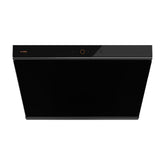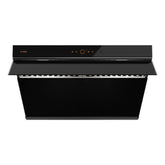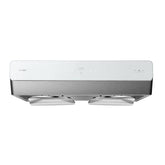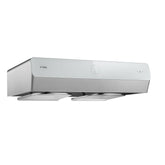How to Vent a Range Hood: All Venting Options
Last Updated: 8/7/2024
Author: James Zhao, Sr. Tech Specialist & Alex Park, Product Specialist
Many homeowners struggle with inadequate ventilation in their kitchens, leading to unpleasant odors and unsightly messes that detract from the joy of cooking. When it comes to keeping your kitchen fresh and free from cooking odors and grease, a reliable range hood is essential for any family. However, installing a range hood involves more than just picking out the right model. Proper venting is essential to ensure that your kitchen remains clean at all times.
In this comprehensive guide, we walk you through all the venting options available, empowering you to make the best choice for your kitchen. From horizontal and vertical ductwork to venting options such as roof, wall, and ceiling venting, we cover it all. We also teach you how to vent a range hood with our easy-to-follow step-by-step instructions.
Say goodbye to stubborn odors and hello to a cleaner, more enjoyable kitchen. Explore FOTILE's extensive selection of range hoods online today.
Range Hood Venting Options
When it comes to installing a range hood, choosing the right ductwork configuration is crucial for ensuring optimal ventilation in your kitchen. The ductwork options available can significantly impact the effectiveness of your range hood in removing cooking byproducts such as grease, smoke, and odors. In this section, we'll explore the various ductwork options, helping you understand the benefits and considerations of horizontal and vertical duct configurations.
At FOTILE, our range hoods provide the flexibility and performance you require, regardless of your kitchen layout. With innovative features and superior build quality, our range hoods ensure your kitchen remains fresh and clean, making cooking a more enjoyable experience. Browse our collection of range hoods and discover the one that meets your specific needs and style preferences.
Horizontal Duct (Wall Hoods)
Horizontal ductwork is a popular choice for venting range hoods, especially in kitchens with a direct path to an exterior wall. This ductwork configuration involves running ducts horizontally through the interior wall to expel cooking byproducts outside. This is often a recommended venting option as hot air rises.
At FOTILE, our wall-mounted range hoods with horizontal ductwork are among our best-selling models. Homeowners love them for their efficiency, sleek design, and superior performance. These range hoods provide optimal ventilation while enhancing the aesthetic appeal of your kitchen. Browse our popular models in the perimeter vent series collection and elevate your kitchen's ventilation system.
Vertical Duct (Ceiling Hoods)
In kitchens without convenient access to an exterior wall, vertical ducts provide an alternative venting solution. Vertical ductwork involves routing ducts vertically through the ceiling or cabinets to expel cooking byproducts through the roof.
These ceiling hoods are our newest range hoods, offering superior ventilation with vertical ductwork. These innovative models ensure your kitchen stays fresh and clean, regardless of your layout. Explore our collection of island range hoods, perfect for kitchens that require vertical ducting solutions.
Ducted vs. Ductless Range Hoods
Ducted range hoods, also known as exhaust or slant vent range hoods, operate by expelling air outside through ductwork connected to an exterior vent. Ducted range hoods offer superior ventilation performance, making them the preferred choice for active kitchens where heavier smoke may be more common.
Ductless range hoods, including our collection in the Pixie Air series, utilize charcoal or carbon filters to trap cooking odors, grease, and smoke before recirculating clean air back into the kitchen. While ductless range hoods do not require ductwork installation, they are less efficient at removing pollutants compared to their ducted counterparts.
Ultimately, the choice between ducted and ductless range hoods depends on your specific ventilation requirements, budget, and kitchen layout. Ducted range hoods excel in providing powerful and efficient ventilation, while ductless range hoods offer flexibility and convenience in installation. By weighing the advantages and limitations of each option, you can select the ventilation solution that best suits your needs and ensures a clean, odor-free kitchen environment.
Step-by-Step Guide to Venting a Ducted Range Hood
Installing a ducted range hood is a straightforward process that can significantly improve the ventilation in your kitchen. Follow this step-by-step guide to ensure a seamless installation process and optimal performance from your range hood:
Taking Measurements & Selecting the Proper Ducting Location
Before you begin the installation, carefully measure the distance between your range hood and the exterior wall or roof where the ductwork will be vented. This measurement will determine the length of ductwork needed for proper ventilation.
Additionally, consider the layout of your kitchen and select a ducting location that provides the most direct path for greasy air to exit the kitchen. Choose a location that minimizes bends and turns in the ductwork to optimize airflow and ventilation efficiency.
Securing the Adapter to the Ductwork
Once you've selected the ducting location, secure the adapter provided with your range hood to the ductwork using appropriate fasteners. Ensure that the adapter is tightly secured to the ductwork to prevent air leaks and maximize ventilation effectiveness. Use sealant or duct tape to further seal any gaps between the adapter and the ductwork, ensuring airtight connections that prevent air from escaping into the kitchen.
Installing the Ductwork
With the adapter securely in place, proceed to install the ductwork according to the manufacturer's instructions. Use adjustable elbows, fittings, and duct connectors as needed to navigate corners and obstacles in your kitchen layout. Be sure to follow local building codes and regulations regarding ductwork installation to ensure compliance and safety. As you install the range hood duct, double-check measurements and alignments to ensure proper fit and alignment with the range hood and exterior venting point.
Connecting the Range Hood to the Ducts
Once the ductwork is installed, it's time to connect your range hood to the ducts. Position the range hood in its designated location, ensuring that it aligns properly with the ductwork and adapter. Secure the range hood to the wall or cabinet according to the manufacturer's instructions using sheet metal screws or mounting hardware.
Then, connect the range hood to the ductwork using the provided connectors or clamps. Ensure that all connections are tight and secure to prevent air leaks and maximize ventilation efficiency.
Testing the Range Hood
Before completing the installation process, it's essential to test the range hood to ensure that it's functioning correctly. Turn on the range hood and observe the airflow and ventilation performance. Check for any unusual noises, vibrations, or odors that may indicate a problem with the installation or operation of the range hood. Conducting thorough testing ensures that your range hood is installed correctly and ready to provide reliable ventilation in your kitchen.
Options for Ductless Installation of Range Hoods
Ductless installation eliminates the need for cumbersome ductwork by employing advanced filtration technology to purify the air within your kitchen. While ductless installation offers convenience and flexibility, it's important to consider factors such as kitchen size and cooking frequency to ensure optimal performance.
The process begins with mounting the range hood in your desired location, ensuring optimal coverage and easy access. Charcoal filters, designed to effectively capture cooking odors, grease, and smoke particles, are then installed within the range hood. These filters absorb and neutralize odors, ensuring that only clean, fresh air is recirculated back into the kitchen. While ductless range hoods do not vent air outside like their ducted counterparts, they are highly efficient at removing pollutants from indoor air, creating a healthier and more enjoyable cooking atmosphere.
Browse FOTILE’s Extensive Selection of Range Hoods Online Today
Whether you need ducted ventilation for the best airflow or want the convenience of ductless installation, FOTILE has the perfect solution to meet your kitchen's unique needs. Explore our range of high-quality range hoods, each designed with innovative features and advanced technology to ensure superior ventilation and air quality in your kitchen. From sleek and modern designs to powerful extraction capabilities, FOTILE range hoods are engineered to exceed your expectations and elevate your culinary space.
Browse FOTILE’s selection of range hoods for ducted or ductless ventilation today.
- Choosing a selection results in a full page refresh.






